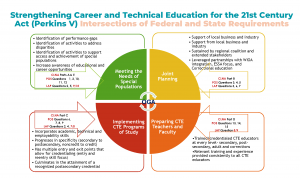Since the fall of 2021, Advance CTE’s Opportunity Gap Analysis (OGA) workshop has provided training, resources, and support to help state leaders identify and address gaps in access to high-quality Career Technical Education (CTE). Since 2021, Advance CTE has led in-depth gap analysis training with 39 state teams from across the country. These teams have further disseminated the gap analysis process within their state CTE systems, resulting in changes in policies and practices that bring identifying and addressing gaps to the forefront of their CTE programs. In this second blog of the series, Senior Policy Associate Jessi Maddox talks with the Louisiana CTE state team to share the impact and lessons learned from implementing OGA in their state.
Over 168,000 learners participate in CTE programs in the Bayou State. Louisiana Community & Technical College System (LCTCS)’s Division of CTE participated in Advance CTE’s Opportunity Gap Analysis workshop in 2021 to explore how to both expand equal access to CTE programs and fully support learners in these programs. After participating in workshops and a community of practice, Louisiana extended its learning across state and local CTE systems.
Tell us about yourself and your CTE background:
LCTCS has an unwavering commitment to ensure that all students—regardless of race, color, national origin, sex, or disability—have equal access to succeed in CTE programs. To this end, we are developing and managing a robust framework that fosters an ethical culture and ensures legal compliance. This includes establishing mechanisms to identify, prioritize, and effectively manage compliance risks associated with federal program subrecipients while also overseeing systems to prevent and detect violations.
We are dedicated to fostering collaboration among educational institutions, workforce entities, and community partners to align CTE programs with regional and local workforce needs. This commitment ensures that a seamless educational pathway from K-12 through university to sustainable employment in CTE fields is promoted, with clear transitions from education to career. To support this, we ensure that blended professional development is available for all educational instructors and leaders, offering access to relevant education, workplace training, and credentialing.
When did your state participate in the Opportunity Gap Analysis Workshop, and what in-state training(s) has your team facilitated using the workshop model and/or related resources?
LCTCS participated in the Opportunity Gap Analysis workshop in September 2021 with a team represented by the State Director for Career and Technical Education and Assistant Director for Career and Technical Education.
Since participating in the workshops the LCTCS team has launched the in-state Opportunity Gap Analysis at our Annual Conference in November 2021 with four virtual sessions, open to all attendees, to spark interest of CTE educators and administrators in the project throughout the system. Four additional workshops followed in 2022 and 2023 targeting implementation of the gap analysis by Postsecondary (PS) CTE and Perkins Coordinators. LCTCS has also implemented communities of practice and participated in cross-state calls to support the work of local administrators.
The graphic below illustrates the expectation that OGA is embedded in narratives of funding applications and integrated into data-driven activities, including the Comprehensive Local Needs Assessment (CLNA), programs of study, and Annual Performance Reports. While the CLNA, funding applications, programs of study, and Annual Performance Reports are part of Federal and State Requirements, OGA amplifies their connections and strengthens the impact of those requirements on learner outcomes.
Describe how your team’s participation in the Opportunity Gap Analysis training impacted CTE in general within your state:
Participating in the Opportunity Gap Analysis has significantly enhanced our team’s data awareness and utilization. This has allowed state agencies to review data using the same parameters when addressing access for all learners. This experience has transformed our approach to data, leading to improved effectiveness in addressing and identifying the needs of all CTE learners.
Describe how the Opportunity Gap Analysis training specifically led to changes in your state’s data policies and procedures:
 The Opportunity Gap Analysis training has prompted significant revisions to Louisiana’s Perkins V program practices and procedures, particularly regarding the CLNA and the postsecondary risk assessment. Subrecipients are now expected to use root cause analysis to align their improvement strategies directly with identified needs. For instance, if CTE students are facing difficulties with course enrollment, retention, or completion, subrecipients use OGA resources to identify barriers to access and success. This data provides the justification for additional resources, such as a wireless headset kit to support learners in an Electrical Construction class.
The Opportunity Gap Analysis training has prompted significant revisions to Louisiana’s Perkins V program practices and procedures, particularly regarding the CLNA and the postsecondary risk assessment. Subrecipients are now expected to use root cause analysis to align their improvement strategies directly with identified needs. For instance, if CTE students are facing difficulties with course enrollment, retention, or completion, subrecipients use OGA resources to identify barriers to access and success. This data provides the justification for additional resources, such as a wireless headset kit to support learners in an Electrical Construction class.
Furthermore, changes to the basic and leadership application reviews mandate that subrecipients provide more precise SMART goals and specify evidence-based strategies or activities. OGA has amplified the inclusion of data. Below is a graphic with an embedded video that illustrates OGA in action, energizing outreach, impacting enrollment, changing the landscape, and empowering learners.
Please describe any steps that have been taken to improve access for CTE learners after going through the CTE opportunity gap analysis process:
Our team has implemented several measures to enhance equal access for all CTE learners. For the 2024-2025 fiscal year, we incorporated the OGA methodology and the Logic Model into the State CLNA Quick Guide. We emphasized the use of evidence-based practices in the review of local application plans (LAP). Specifically, the LAP includes questions that focus on disparities in access and requires detailed information on identified gaps and the strategies to address them. Local grant recipients must identify access gaps found in their CTE programs and use evidence-based action planning to specify the methods used to mitigate said gaps. Furthermore, all subrecipients are expected to employ evidence-based strategies in their improvement plans and performance evaluations, specifying whether the strategy contributed or did not contribute to results. In the example mentioned previously, data was used to justify the purchase of wireless headsets for an Electrical Construction class, which in turn has supported increased enrollments, and more importantly, has contributed to participants continuing and completing the program.
What lessons learned, or outcomes, from your workshop and facilitation experiences would you most like to share with states considering participating in an Opportunity Gap Analysis cohort?
Throughout this process, our team has gained several valuable insights. If we were to share lessons learned with other states, the foremost recommendation would be to revisit the OGA workshop materials frequently and incorporate it as often as possible. Given the frequent staff changes, the need for refresher training for growing understanding and maintaining familiarity with the work is crucial. To address this, we have integrated various activities into grant operations, the grant application process, and most data-related activities.
If your organization is interested in learning more about what it takes to conduct a gap analysis in your state, or other opportunities to engage with Advance CTE’s suite of resources addressing methods to close access gaps, fill out the Technical Assistance Interest Form for personalized options that can help both staff and learners succeed.
If you missed the first installation in this series, you can catch up with Iowa’s Bureau of Community Colleges and Postsecondary Readiness, and how they have integrated the Opportunity Gap Analysis training into their state policies and practices here.






 Fellows were also asked to share the key event or events that reinforced their decision to apply to the Fellowship, in other words – when they knew they made the right decision. Dr. Gardner shared that in CTE she rarely has an opportunity to work with or collaborate with other leaders of color across the nation and view the entire landscape of leadership possibilities in postsecondary CTE. The Fellowship offered an opportunity to build a network consisting of her peers, guest speakers invited to the Fellowship workshop and most importantly her coach whom she felt she was perfectly matched with based on their commonalities and interests. She recognized the level of thought the Advance CTE staff dedicated to finding the right mentor for each of the Fellows. Caleb discussed being paired with a postsecondary administrator with an automotive background and how the monthly coaching meetings inspired him to begin seeking the director position he currently holds at his institution.
Fellows were also asked to share the key event or events that reinforced their decision to apply to the Fellowship, in other words – when they knew they made the right decision. Dr. Gardner shared that in CTE she rarely has an opportunity to work with or collaborate with other leaders of color across the nation and view the entire landscape of leadership possibilities in postsecondary CTE. The Fellowship offered an opportunity to build a network consisting of her peers, guest speakers invited to the Fellowship workshop and most importantly her coach whom she felt she was perfectly matched with based on their commonalities and interests. She recognized the level of thought the Advance CTE staff dedicated to finding the right mentor for each of the Fellows. Caleb discussed being paired with a postsecondary administrator with an automotive background and how the monthly coaching meetings inspired him to begin seeking the director position he currently holds at his institution.  Tell me more about your journey to the Fellowship.
Tell me more about your journey to the Fellowship.


 Lawmakers Return to Capitol Hill
Lawmakers Return to Capitol Hill
 The Georgetown Center on Education and the Workforce (CEW) recently
The Georgetown Center on Education and the Workforce (CEW) recently 